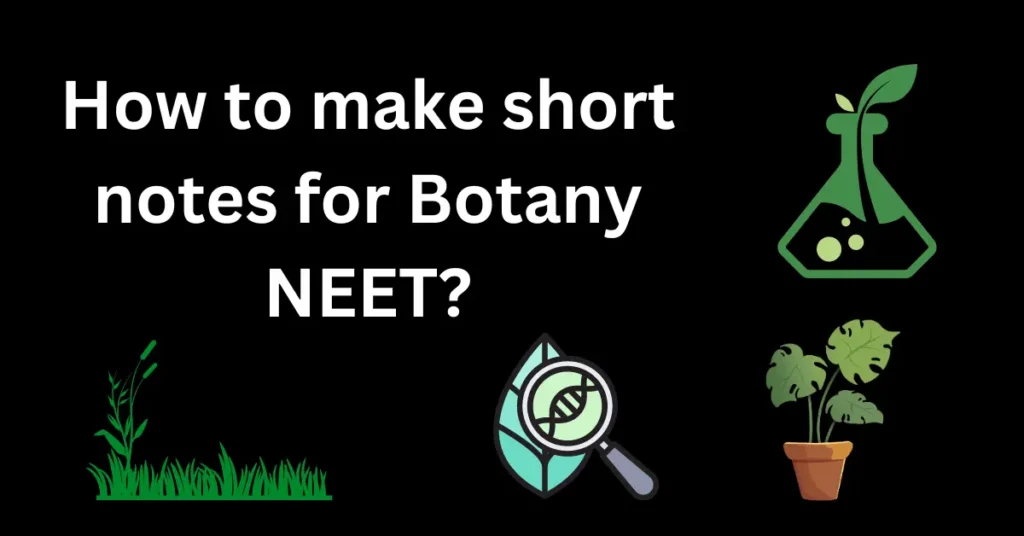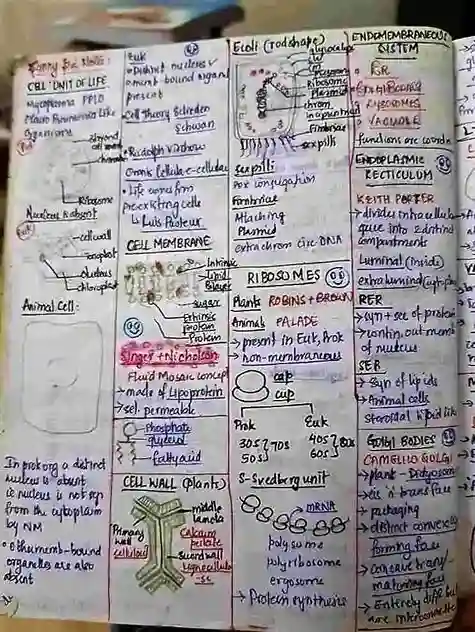
Preparing short notes for a highly theoretical subject like Botany is an excellent preparation strategy for the NEET exam. Botany short notes aid you in revising quickly.
Sadly, many students don’t know how to make short notes for Botany NEET. Students are unaware of how many details they should include in their short notes.
If you happen to be one of those students, then do not worry, as this article will teach you how many details you should put in your short notes.
Also, you will get to know which study material you should make use of to prepare short notes, whether NCERT books, reference books like Objective Botany By Ansari, detailed notes provided by your school/coaching institute, etc.
Read Also: How to make short notes for Zoology NEET?
Tools needed to make short notes for Botany NEET
1. A4 size paper or good quality notebooks: A4 size papers of good quality will be required. If you don’t like writing on A4-sized papers, use notebooks and make sure that the notebooks are of good quality.
2. Colored pens: With the help of colored pens, make your short notes more visually attractive.
3. Highlighters: Highlight key points of a topic with the help of highlighters. When you revise, the highlighted points stand out.
Read Also: How to make short notes for Organic Chemistry NEET?
What you should include In Botany short notes for NEET?
1. Plant Kingdom
Give an overview of the major plant groups – algae, bryophytes, pteridophytes, gymnosperms, and angiosperms. Also, briefly write the characteristics of these plant groups.
Read Also: How to make short notes for Inorganic Chemistry NEET?
2. Structural Organization in Animals
Give an overview of the structure and function of the different parts of plants, such as roots, stems, leaves, flowers, and fruits. Also, describe briefly the types of tissues and their functions.
3. Plant Cell
Include a neat, well-labeled diagram of the plant cell. Briefly describe the functions of the different parts of the plant cell, like the cell wall, nucleus, cytoplasm, etc.
4. Plant Physiology
Explain, in short, the various plant processes like photosynthesis, respiration, plant growth regulators, transpiration, mineral nutrition, etc.
5. Reproduction In Plants
Explain briefly about types of reproduction in plants(sexual and asexual reproduction). Also, describe in short about pollination mechanisms, fertilization, seed formation, etc.
6. Genetics And Plant Breeding
In summary, explain the principles of genetics, Mendelian inheritance, gene expression, plant breeding techniques, hybridization, etc.
7. Ecology And Environment
Give an overview of the concepts of ecology, ecosystems, biodiversity, conservation, environmental issues concerning plants, etc.
Read Also: How to make short notes for Physical Chemistry NEET?
From where do you need to make NEET Botany short notes?
1. Class Notes: From the detailed Botany notes provided by your coaching institute for school, make short notes.
2. NCERT Books: Read a topic or chapter from NCERT Biology ( botany section) and prepare short notes from it.
Read Also: How to make notes from NCERT for NEET?
3. Reference Books: You can also make short notes from well-known reference books like Objective Botany By Ansari, Biology Vol 1 and Vol 2 by Trueman, etc.
4. Coaching Study Materials:.Prepare short notes from the printed study materials provided by your coaching institute.
5. Exercise Questions: Write down the exercise questions as well as their solutions from the NCERT book or reference book that you feel are important.
6. Tests And Previous Year Questions: Include the challenging questions and their solutions from the mock tests you took. Also, for the previous year questions (PYQs), repeat the same process.
Read Also: How to make short notes for NEET Physics?
How to make short notes for Botany NEET? – Tips
1. Read And Understand
Before preparing short notes read the chapter or topic several times until you understand it completely. You may read from NCERT books, reference books such as Objective Botany By Ansari, detailed Botany notes, or study material provided by your coaching institute.
2. Structure Your Notes

Take a look at the image above and create four columns on a notebook page or an A4 size paper. Use headings and subheadings for every topic so that the notes are structured properly.
Use bullet points to list important concepts, essential definitions, important differences (e.g., the difference between pollination and fertilization), etc.
3. Summarize
Including too many details about a topic is not beneficial; always summarize the topic in short points from a variety of study materials like NCERT books, reference books, detailed notes, etc.
4. Abbreviations
Make use of abbreviations wherever it is possible. For example, write “PMC” for Pollen Mother Cell, “MMC” for Megaspore Mother Cell, etc.
5. Make your notes visually appealing
Notes that are colorful are very easy to read and revise. With the aid of colored pens, make your Botany short notes more visually appealing. Using colored pens, write important definitions, label diagrams, etc.
6. Practice Questions
Only include the most essential practice questions and their solutions that are not easy and challenging to answer in your Botany short notes.
Include practice questions from NCERT books, reference books, printed study materials provided by your coaching institute, or detailed notes provided by your coaching institute.
7. Mock Tests & PYQs
In your Botany short notes, write only the questions and their solutions that you feel are important and not easy to answer from the mock tests you have attempted. Also, repeat the same procedure for PYQs.
8. A chapter should have one or two pages
When preparing Botany short notes for NEET, make sure that every chapter is at most two pages long.
9. Highlight
Make use of highlighters to mark important concepts of a topic. Also, mark essential definitions, exercise questions, mock test questions, or PYQs. The points which you highlighted will stand out during revision.
Read Also: Which type of notes are best for NEET?
Conclusion
Many aspirants preparing for the NEET exam find Botany a little difficult to revise and remember as this subject can be hard to understand for some students.
If you plan to revise Botany from NCERT books, reference books, or detailed notes, it may not be a good revision strategy. Concise and well-structured notes are very beneficial for last-minute revisions when the NEET exam date draws closer.
Try to make the notes as short as possible, such that a chapter should not have more than two pages. Include only the critical concepts of a topic, important definitions, labeled diagrams, etc.
Make use of abbreviations appropriately wherever possible. With the aid of colored pens and highlighters, make your Botany short notes more visually attractive.
One of the main advantages of preparing short notes for a vast subject like Botany is that you are also simultaneously revising the chapter or topic.
Finally, before you start preparing short notes for Botany, read and grasp the topic properly and only then start making short notes.
Read Also: Is it important to make notes for NEET?
Frequently Asked Questions
Q1. Are short notes useful for NEET Botany?
Yes, Botany, short notes, if prepared correctly, will help you revise quickly for the NEET exam.
Q2. Should I include PYQs in Botany short notes for NEET?
Yes, add those PYQs that are challenging to answer and are asked several times in the NEET exam.
Q3. When should I start making short notes for Botany NEET?
Start making Botany short notes after understanding a chapter or topic properly by reading from various study materials like NCERT, reference books, detailed notes, etc.
Q4. Can I buy NEET Botany short notes?
Yes, NEET Botany short notes can be purchased from popular ecommerce websites like Amazon, Flipkart, etc.
Q5. Should I include every detail in my NEET Botany short notes?
No, you should only include important definitions, crucial concepts of a topic, labeled diagrams, etc.